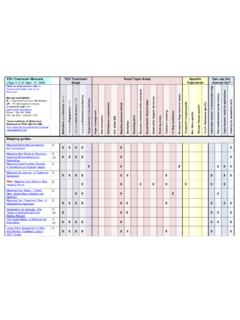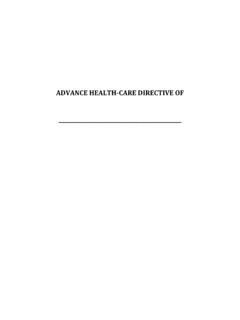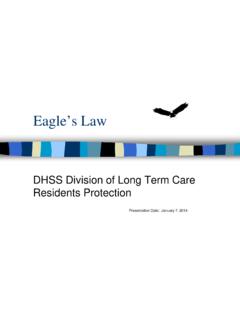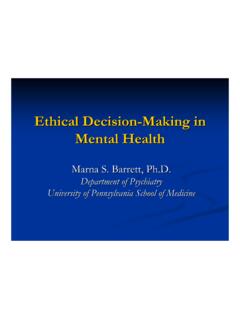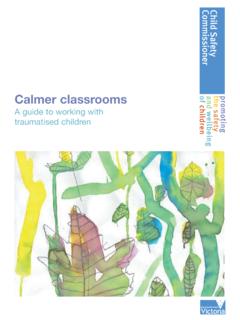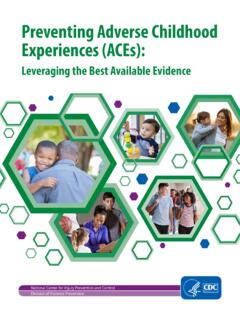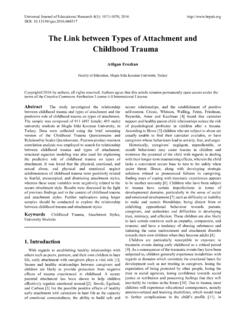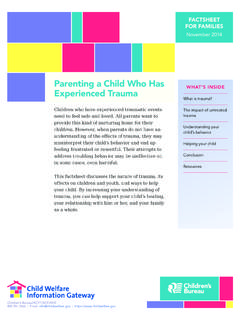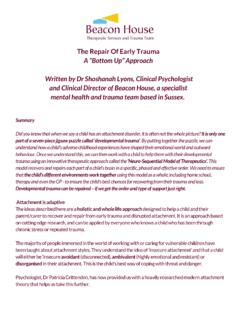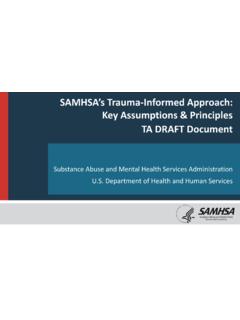Transcription of Beyond Trauma: A Healing Journey for Women
1 Beyond trauma : A Healing Journey for WomenBeyond trauma : A Healing Journey for WomenCurriculum written byStephanie S. Covington, , LCSWT raining provided by Carol Ackley, LADCC risis=Danger & OpportunityCrisis=Danger & OpportunityLevels of ViolenceLevels of Violence Childhood Adolescence Adult Street (workplace and community) Consumer Culture Media War PlanetTwo Kinds of SufferingTwo Kinds of Suffering Natural CreatedDefinition of TraumaDefinition of TraumaThe diagnostic manual used by mental health providers (DSM IV-TR) defines trauma as, involving direct personal experience of an event that involves actual or threatened death or serious injury, or other threat to one s physical integrity; or a threat to the physical integrity of another person; or learning about unexpected or violent death, serious harm, or threat of death or injury experienced by a family member or other close associate. (American Psychiatric Assoc.)
2 [APA] 2000, pg. 463).Definition of trauma (cont.)Definition of trauma (cont.) The person s response to the event must involve intense fear, helplessness or horror (or in children, the response must involve disorganized or agitated behavior). (American Psychiatric Assoc. [APA] 2000, pg. 463).Violence Against WomenViolence Against WomenViolence against Women is so pervasive that the United Nations has addressed and defined violence against Women as any act of gender-based violence that results in, or is likely to result in, physical, sexual or psychological harm or suffering to Women , including threats of such acts, coercion or arbitrary deprivations of liberty, whether occurring in public or private life. (United Nations General Assembly, 1993).Gender-Responsive Services Gender-Responsive Services Gender-ResponsivenessCreating an environment through site selection, staff selection, program development, content, and material that reflects an understanding of the realities of the lives of Women and girls and that addresses and responds to their strengths and challenges.
3 (Covington & Bloom)Theoretical FoundationTheoretical FoundationThe theories related to gender and substance abuse (and any other relevant treatment services) that create the framework of thought for program development. This is the knowledge base that creates the foundation upon which the program is StrategiesTreatment StrategiesThe approaches used in the program that create the therapeutic process. These are the ways in which theory is operationalized(how theory is applied). Women s Issues:An International PerspectiveWomen s Issues:An International Perspective Shame and Stigma Physical and Sexual Abuse Relationship Issues fear of losing children fear of losing partner needing partner s permission to obtain treatmentWomen s Issues:An International PerspectiveWomen s Issues:An International Perspective Treatment Issues lack of services for Women not understanding treatment long waiting lists lack of childcare services Systemic Issues lack of financial resources lack of clean/sober housing poorly coordinated servicesThe PastThe FutureDEEPERPSYCHICCHANGECOGNITIVEINTERV ENTIONS Trust in othersand in yourself Courageto do new things To like yourself as a womanManaging Conflicts Relationships Relapseprevention Workingtogether SocialplanningLotta L nne, Sweden, 2006 Helping Women Recover:A Comprehensive Integrated ApproachHelping Women Recover.
4 A Comprehensive Integrated Approach Theory of Addiction Holistic health model Chronic neglect of self in favor of something orsomeone else Theory of Women s Psychological Development Relational Cultural Model (Stone Center) Theory of trauma Three Stage Model (Herman) Upward Spiral A Transformational Model (Covington) Voices:A Program of Self-discovery and Empowerment for GirlsVoices:A Program of Self-discovery and Empowerment for Girls Theory of Girls Psychological Development Relational Cultural Model (Stone Center, Gilligan, Brown)Theory of Attachment Ainsworth, Bowlby, Harlow, SternTheory of trauma Three Stage Model (Herman) Transformational Spiral (Covington)Theory of Resilience Biscoe, Wolin & WolinTheory of Addiction Holistic Health ModelBeyond trauma : A Healing Journey for WomenBeyond trauma : A Healing Journey for WomenTrauma TheorySandra Bloom, Harvey, Herman, Levine, cognitive-behavioral, expressive arts, guided imagery, and relational therapy.
5 Therapeutic culture has these elements Therapeutic culture has these elements Attachment: a culture of belonging Containment: a culture of safety Communication: a culture of openness Involvement: a culture of participation and citizenship Agency: a culture of empowerment(Haigh)Three Critical and Interrelated IssuesThree Critical and Interrelated Issues Substance Abuse Mental Health TraumaRelational-Cultural TheoryRelational-Cultural TheorySome Women use drugs: To maintain a relationship To fill in the void of what s missing in a relationship To self-medicate the pain of abuse in relationships(Covington & Surrey, 1997) trauma -informed ServicesTrauma-informed Services These are services that are provided for problems other than trauma but require knowledge about violence against Women and the impact of trauma thereby increasing their ServicesTrauma-informed ServicesTrauma-informed services:1. Take the trauma into Avoid triggering trauma reactions and/or traumatizing the Adjust the behavior of counselors, other staff and the organization to support the individual s coping Allow survivors to manage their trauma symptoms successfully so that they are able to access, retain and benefit from the services.
6 (Harris & Fallot)Ten Principles of trauma -Informed ServicesTen Principles of trauma -Informed ServicesPrinciple Services Recognize the Impact of Violence and Victimization on Development and Coping StrategiesTen Principles of trauma -Informed Services (cont.)Ten Principles of trauma -Informed Services (cont.)Principle Services Identify Recovery from trauma as a Primary GoalTen Principles of trauma -Informed Services (cont.)Ten Principles of trauma -Informed Services (cont.)Principle Services Employ an Empowerment ModelTen Principles of trauma -Informed Services (cont.)Ten Principles of trauma -Informed Services (cont.)Principle Services Strive to Maximize a Woman s Choices and Control Over Her RecoveryTen Principles of trauma -Informed Services (cont.)Ten Principles of trauma -Informed Services (cont.)Principle Services Are Based in a Relational CollaborationTen Principles of trauma -Informed Services (cont.)Ten Principles of trauma -Informed Services (cont.)Principle Services Create an Atmosphere That Is Respectful of Survivor s Need for Safety, Respect, and AcceptanceTen Principles of trauma -Informed Services (cont.)
7 Ten Principles of trauma -Informed Services (cont.)Principle Services Emphasize Women s Strengths, Highlighting Adaptation Over Symptoms and Resilience Over PathologyTen Principles of trauma -Informed Services (cont.)Ten Principles of trauma -Informed Services (cont.)Principle Goal of trauma -Informed Services Is to Minimize the Possibilities of RetraumatizationTen Principles of trauma -Informed Services (cont.)Ten Principles of trauma -Informed Services (cont.)Principle Services Strive to Be Culturally Competent and to Understand Each Woman in the Context of Her Life Experiences and Cultural BackgroundTen Principles of trauma -Informed Services (cont.)Ten Principles of trauma -Informed Services (cont.)Principle Agencies Solicit Consumer Input and Invoice Consumers in Designing and Evaluating ServicesElliot, ; Bjelajac, P.; Fallot, ; Markoff, ; Reed, trauma -Informed or trauma -Denied: Principles and Implementation of trauma -Informed Services for Women . Journal of Community Psychology, July, 2005.
8 , 33(4): Specific ServicesTrauma Specific ServicesServices designed specifically to address violence, trauma , and related symptoms and reactions. The intent of the activities is to increase skills and strategies that allow survivors to manage their symptoms and reactions with minimal disruption to their daily obligations and to their quality of life; and eventually to reduce or eliminate debilitating symptoms and to prevent further traumatization and following statistics illustrate how pervasive interpersonal violence is in the lives of Women and girls. The strongest risk factor for being a victim of partner violence is being female. (APA, 1996) Approximately million Women are raped or physically assaulted by an intimate partner each year in the US. (Bureau of Justice Statistics [BJS], 2000).StatisticsStatistics Violence against the woman occurs in approximately 20 percent of dating couples (APA, 1996).
9 Women age 16-24 experience the highest per capita rates of intimate violence ( victimizations per 1,000 Women )(BJS, 2002). Violence within the family is traumatizing to most Women . (APA, 1996). StatisticsStatistics While both male and female children are at risk for abuse, females continue to be at risk for interpersonal violence in their adolescence and adult lives. (Covington & Surrey). In 1998, over 1,800 murders in the US were attributed to intimate partners. Three quarters of the victims were Women , accounting for 33% of all murders of Women and 4% of all murders of men. (BJS, 2000a).StatisticsStatistics More female than male adolescents have been sexually assaulted. (Commonwealth Fund, 1997). An estimated 67 of every 100,000 females in the United States were reported rape victims in 1998. Despite a decline in the nation s crime rate, over the past decade, reported rates of rape and sexual assault did not decline.(FBI, 1999).StatisticsStatistics Only 22 percent of rapes are committed by someone the victim does not know.
10 (Kilpatrick, Acierno, Saunders, Resnick, Best, & Schnurr, 1998). While relationship violence happens to Women of every race and ethnic background, African-American Women are physically assaulted at a rate that is 35% higher than Caucasian Women , and about 2-1/2 times the rate of Women of other races. (National Coalition Against Domestic Violence, 2000). StatisticsStatistics 1/3 of Women in state prison and 1/4 in jails said they had been raped (BJS, 1999). Women in prison reported childhood abuse at a rate almost twice that of men; abuse of Women as adults was eight times higher than the rate for men (Messina et. al., 2001). Between 23-37% of female offenders reported that they had been physical or sexually abused before the age of 18 (BJS, 1999).Sexual Assault GraphSexual Assault GraphBureau of Justice StatisticsSexual Assault GraphSexual Assault GraphBureau of Justice StatisticsProcess of TraumaProcess of TraumaTRAUMATIC EVENT Overwhelms the Physical & Psychological SystemsIntense Fear, Helplessness or Horror SENSITIZED NERVOUS SYSTEMCHANGES IN BRAINCURRENT STRESSR eminders of trauma , Life Events, Lifestyle PAINFUL EMOTIONAL STATERETREATSELF-DESTRUCTIVE ACTIONDESTRUCTIVE ACTIONISOLATIONDISSOCIATIONDEPRESSIONANX IETYSUBSTANCE ABUSEEATING DISORDERDELIBERATE SELF-HARMSUICIDAL ACTIONSAGGRESSIONVIOLENCERAGESRESPONSE TO TRAUMAF ight or Flight, Freeze, Altered State of Consciousness, Body Sensations, Numbing, Hyper-vigilance, Hyper-arousalBrainBrainLeft Side of BrainRight Side of Brain Analytic Intuitive Logical EmotionalACE Study(Adverse Childhood Experiences)ACE Study(Adverse Childhood Experiences)

